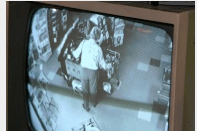I work for a small retail pharmacy. We are located in an inner city setting within close proximity to several highways so we battle petty theft as well as the professional boosters. It’s a perfect storm. I try to shop local small businesses when I need something, whether it be for my home or even for my store. I am always on the lookout for new ways to stop shoplifting and I tend to pay close attention to what my neighbors are doing. The first thing I look for is the presence of Checkpoint Systems. If they do have a system in place, I look around to see what types of items or categories they have incorporated Checkpoint tags. It’s a good idea to know what is being targeted in other stores because you never know what you may get hit for next, especially if you carry similar items.
I had to go to a local dollar store last week because I needed supplies for my store that we don’t sell. For one, someone had stolen the toilet paper roller from the restroom. Yes, someone really stole that from our public restroom, presumably because they needed one. I hope it wasn’t just to be a jerk. Anyway, I went to this store and I made my usual observations. First of all, Checkpoint Systems were clearly in place and being utilized. And by being utilized, I actually mean they were working it to death. It was like I was in a Checkpoint Systems wonderland. This store staff tags EVERYTHING. I was in the back of the store checking around the housewares and I was simply amazed. Shower curtains, window curtains, sheet sets, and even table cloths all had Checkpoint Tags attached. They put them on the packs of socks, baby blankets, and even on bug spray bombs. These employees had tags on all the bags of beef jerky! Obviously, retail theft prevention is a priority for the manager or owner of this location. I could see cameras on the ceiling that looked like the whole place was covered with surveillance. It was, in my mind, a loss prevention department’s dream. When I walked up to the guy running the front I had to ask about the extreme measures they were taking to stop shoplifting. I told him about our restroom bandit and my reason for being there. He said they had to tag all their stuff because of all the theft that occurred there before. He then smirked at me and said they still steal the soap from our bathrooms. Oh well, you can’t win them all.
Now I have to admit, I don’t think I have the time or energy to start mega-tagging like this store does. And honestly, I don’t have that kind of need for it either. However, as a store manager, I do what I need to do and so do they. There’s another store close by that I shop and they don’t have a clue. Merchandise walks out of that store on a daily basis, and if they know it, they don’t make any changes to their business model. Checkpoint Systems will give you a return on your investment. When you use serious asset protection tools, you keep your bottom line in the black. Shrink can be reduced and thefts can be deterred as long as you know what you are losing and you do something about it.
For more information on Checkpoint Systems, contact us or call 1.770.426.0547
 The cost of cyber security for retailers seems to double year after year. The cost of a data breach in this country in 2014 cost the retailer an average of
The cost of cyber security for retailers seems to double year after year. The cost of a data breach in this country in 2014 cost the retailer an average of I don’t care about solving social problems. I don’t care about saving the world (okay maybe I really do). But I cannot fix many of these things myself. I cannot make shoplifters change their evil trade for real work. But I can make shoplifters go somewhere else and leave my customers alone.
I don’t care about solving social problems. I don’t care about saving the world (okay maybe I really do). But I cannot fix many of these things myself. I cannot make shoplifters change their evil trade for real work. But I can make shoplifters go somewhere else and leave my customers alone.  Over the past five years or so, social media platforms have exploded. Sites like Facebook, Twitter, or Instagram are essentially a one stop shop for all your news, entertainment and whatever your Aunt Dolly is doing today… Like most Americans, I visit these websites frequently throughout the day (although, I am weaning myself off this addiction slowly, but surely). Businesses have also been quick to jump on the bandwagon and have found that direct to consumer marketing, especially the free kind of marketing, can really help a small business soar. With so many people, places and things interconnected, you can see how the Loss Prevention Industry uses these platforms to not only aid in investigations, but to help track down fencing operations, retail ORC groups and even dishonest employees.
Over the past five years or so, social media platforms have exploded. Sites like Facebook, Twitter, or Instagram are essentially a one stop shop for all your news, entertainment and whatever your Aunt Dolly is doing today… Like most Americans, I visit these websites frequently throughout the day (although, I am weaning myself off this addiction slowly, but surely). Businesses have also been quick to jump on the bandwagon and have found that direct to consumer marketing, especially the free kind of marketing, can really help a small business soar. With so many people, places and things interconnected, you can see how the Loss Prevention Industry uses these platforms to not only aid in investigations, but to help track down fencing operations, retail ORC groups and even dishonest employees. Ever notice how so many different shoplifters, from various backgrounds and demographics all share similar characteristics in the manner in which they steal, the product that they steal and the methods used to conduct their acts? Well, I did and it really got me thinking. Why was this so? Is there some large underground shoplifting network where this information is swapped amongst the thieving brethren? Kind of.
Ever notice how so many different shoplifters, from various backgrounds and demographics all share similar characteristics in the manner in which they steal, the product that they steal and the methods used to conduct their acts? Well, I did and it really got me thinking. Why was this so? Is there some large underground shoplifting network where this information is swapped amongst the thieving brethren? Kind of. What is the most important factor to consider when you make a shoplifting apprehension?
What is the most important factor to consider when you make a shoplifting apprehension?
 Using Facebook, their own websites and other social media outlets, many retailers have for years posted
Using Facebook, their own websites and other social media outlets, many retailers have for years posted